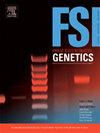An Integrated proteomic workflow for body fluid classification and single amino acid variant identification: Advancing towards body fluid source attribution
IF 3.1
2区 医学
Q2 GENETICS & HEREDITY
引用次数: 0
Abstract
A particularly challenging subject in the investigation of forensic human biological traces is analyzing samples containing mixtures of body fluids from multiple donors. Ideally, researchers want to identify each type of body fluid present. However, traditional methods, like mRNA and DNA profiling, often struggle with sensitivity, specificity, and efficiency, especially in complex mixtures. This proof-of-concept study has two primary aims: first, to classify body fluids within a mixture using discriminatory protein markers, and second, to evaluate the feasibility of using single amino acid variants (SAAVs) to trace the source of specific body fluids back to individual donors. To achieve this, we employed proteomic analysis via liquid chromatography-tandem mass spectrometry (LC-MS/MS) in data-independent acquisition (DIA) mode, developing a reliable approach for accurate body fluid classification. Through comprehensive proteomic profiling, we characterized a diverse array of discriminatory proteins present in peripheral blood, semen, saliva, urine, and vaginal fluid. Using advanced data analysis techniques, including t-distributed stochastic neighbor embedding (t-SNE), we demonstrated that these proteins could reliably distinguish between different body fluids, even in mixed samples. Additionally, our findings reveal that SAAVs within certain proteins, such as those in saliva, hold promise for source attribution in a forensic context. Challenges, including contamination and limited sample sizes, highlighted the need for strict quality controls and further large-scale studies. With these improvements, proteomic analysis could greatly enhance body fluid identification, classification, and source attribution in forensic investigations, improving both accuracy and reliability in forensic science.
体液分类和单氨基酸变异鉴定的集成蛋白质组学工作流程:体液来源归属研究进展
在调查法医人类生物痕迹方面,一个特别具有挑战性的课题是分析含有多个供体体液混合物的样本。理想情况下,研究人员希望能识别出存在的每种体液。然而,传统的方法,如mRNA和DNA分析,经常在敏感性,特异性和效率方面挣扎,特别是在复杂的混合物中。这项概念验证研究有两个主要目的:第一,使用歧视性蛋白质标记物对混合物中的体液进行分类,第二,评估使用单氨基酸变体(saav)追踪特定体液来源的可行性,以追溯到个体供体。为了实现这一目标,我们采用数据独立采集(DIA)模式,通过液相色谱-串联质谱(LC-MS/MS)进行蛋白质组学分析,开发了一种可靠的准确体液分类方法。通过全面的蛋白质组学分析,我们表征了外周血、精液、唾液、尿液和阴道液中存在的多种歧视性蛋白质。使用先进的数据分析技术,包括t分布随机邻居嵌入(t-SNE),我们证明这些蛋白质可以可靠地区分不同的体液,即使在混合样本中。此外,我们的研究结果表明,某些蛋白质中的saav,如唾液中的saav,在法医环境中具有来源归属的希望。污染和样本量有限等挑战凸显了严格质量控制和进一步大规模研究的必要性。有了这些改进,蛋白质组学分析可以大大提高法医调查中的体液鉴定、分类和来源归属,提高法医科学的准确性和可靠性。
本文章由计算机程序翻译,如有差异,请以英文原文为准。
求助全文
约1分钟内获得全文
求助全文
来源期刊
CiteScore
7.50
自引率
32.30%
发文量
132
审稿时长
11.3 weeks
期刊介绍:
Forensic Science International: Genetics is the premier journal in the field of Forensic Genetics. This branch of Forensic Science can be defined as the application of genetics to human and non-human material (in the sense of a science with the purpose of studying inherited characteristics for the analysis of inter- and intra-specific variations in populations) for the resolution of legal conflicts.
The scope of the journal includes:
Forensic applications of human polymorphism.
Testing of paternity and other family relationships, immigration cases, typing of biological stains and tissues from criminal casework, identification of human remains by DNA testing methodologies.
Description of human polymorphisms of forensic interest, with special interest in DNA polymorphisms.
Autosomal DNA polymorphisms, mini- and microsatellites (or short tandem repeats, STRs), single nucleotide polymorphisms (SNPs), X and Y chromosome polymorphisms, mtDNA polymorphisms, and any other type of DNA variation with potential forensic applications.
Non-human DNA polymorphisms for crime scene investigation.
Population genetics of human polymorphisms of forensic interest.
Population data, especially from DNA polymorphisms of interest for the solution of forensic problems.
DNA typing methodologies and strategies.
Biostatistical methods in forensic genetics.
Evaluation of DNA evidence in forensic problems (such as paternity or immigration cases, criminal casework, identification), classical and new statistical approaches.
Standards in forensic genetics.
Recommendations of regulatory bodies concerning methods, markers, interpretation or strategies or proposals for procedural or technical standards.
Quality control.
Quality control and quality assurance strategies, proficiency testing for DNA typing methodologies.
Criminal DNA databases.
Technical, legal and statistical issues.
General ethical and legal issues related to forensic genetics.

 求助内容:
求助内容: 应助结果提醒方式:
应助结果提醒方式:


